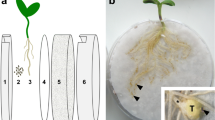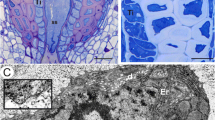Summary
Metaphloem sieve elements from various parts of the plant body ofZea mays L. were examined with the electron microscope. No qualitative differences were found among sieve elements from sources, sinks, and intermediate regions of the plant. At maturity all sieve elements are lined with a parietal layer of cytoplasm, consisting of a plasmalemma, an anastomosing network of endoplasmic reticulum (ER), occasional stacks of ER, mitochondria, and plastids with protein crystalloids. Many mature sieve elements contained persistent, although apparently degenerated nuclei. In addition, in many mature sieve elements the vacuoles apparently continued to be delimited from the parietal cytoplasm by the tonoplast. In most relatively uninjured sieve elements the plasmalemma-lined sieve-plate pores contained little callose and cytoplasmic components and, hence, were largely unoccluded. P-protein was not encountered in any sieve elements at any stage of development.
Similar content being viewed by others
References
Bednarz, R. M. andH. P. Rasmussen, 1972: CO2-fixation sites in leaves of maize and oats. J. Exp. Bot.23, 415–421.
Behnke, D.-H., 1968: Zum Aufbau gitterartiger Membranstrukturen im Siebelementplasma vonDioscorea. Protoplasma66, 287–310.
—, 1969 a: Die Siebröhren-Plastiden der Monocotyledonen. Vergleichende Untersuchungen über Feinbau und Verbreitung eines charakteristischen Plastidentyps. Planta (Berl.)84, 174–184.
—, 1969 b: Aspekte der Siebröhren-Differenzierung bei Monocotylen. Protoplasma68, 289–314.
—, 1969 c: Über den Feinbau und die Ausbreitung der Siebröhren-Plasmafilamente und über Bau und Differenzierung der Siebporen bei einigen Monocotylen und beiNuphar. Proto-plasma68, 377–402.
—, 1972: Sieve-tube plastids in relation to angiosperm systematics-an attempt toward a classification by ultrastructural analysis. Bot. Rev.38, 155–197.
—, 1973: Strukturänderungen des Endoplasmatischen Reticulums und Auftreten von Protein-filamenten während der Siebröhrendifferenzierung beiSmilax excelsa. Protoplasma77, 279–289.
—, undI. Dörr, 1967: Zur Herkunft und Struktur der Plasmafilamente in Assimilatleit-bahnen. Planta (Berl.)74, 18–44.
Burr, F. A. andR. F. Evert, 1973: Some aspects of sieve-element structure and development inSelaginella kraussiana. Protoplasma78, 81–97.
Buvat, R., 1968: Différenciation des cellules criblées du protophloeme dans les jeunes racines d'Orge (Hordeum sativum). C. R. Acad. Sci. (Paris)267, 406–408.
Currier, H. B. andC. Y. Shih, 1968: Sieve tubes and callose inElodea leaves. Amer. J. Bot.55, 145–152.
Eastin, J. A., 1970: C-14 labeled photosynthate export from fully expanded corn (Zea mays L.) leaf blades. Crop Sci.10, 415–418.
Esau, K., 1969: The Phloem. In: Handbuch der Pflanzenanatomie (W. Zimmermann, P. Ozenda, H. D. Wulff, eds.). Histologie, vol. 5, pt. 2. Berlin-Stuttgart: Borntraeger.
— andV. I. Cheadle, 1965: Cytologie studies on phloem. Univ. Calif. Publs. Bot.36, 253–344.
— — andE. B. Risley, 1962: Development of sieve-plate pores. Bot. Gaz.123, 233–243.
Esau, K. andJ. Cronshaw, 1968: Endoplasmic reticulum in the sieve element ofCucurbita. J. Ultrastruct. Res.23, 1–14.
— andR. H. Gill, 1971: Aggregation of endoplasmic reticulum and its relation to the nucleus in a differentiating sieve element. J. Ultrastruct. Res.34, 144–158.
— —, 1972: Nucleus and endoplasmic reticulum in differentiating root protophloem ofNicotiana tabacum. J. Ultrastruct. Res.41, 160–175.
— —, 1973: Correlations in differentiation of protophloem sieve elements ofAllium cepa root. J. Ultrastruct. Res.44, 310–328.
Evert, R. F., C. H. Bornman, J. Butler, andM. G. Gilliland, 1973: Structure and development of the sieve-cell protoplast in leaf veins ofWelwitschia. Protoplasma76, 1–21.
—,J. D. Davis, C. M. Tucker, andF. S. Alfieri, 1970: On the occurrence of nuclei in mature sieve elements. Planta (Berl.)95, 281–296.
— andB. P. Deshpande, 1969: Electron microscope investigation of sieve-element ontogeny and structure inUlmus americana. Protoplasma68, 403–432.
—,W. Eschrich, andS. E. Eichhorn, 1971: Sieve-plate pores in leaf veins ofHordeum vulgare. Planta (Berl.)100, 262–267.
Feder, N., andT. P. O'Brien, 1968: Plant microtechnique: some principles and new methods. Amer. J. Bot.55, 123–142.
Heyser, W., 1971: Phloemdifferenzierung beiTradescantia albiflora. Cytobiologie4, 186–197.
Hofstra, G., andC. D. Nelson, 1969: The translocation of photosynthetically assimilated14C in corn. Canad. J. Bot.47, 1435–1442.
Karnovsky, M. S., 1965: A formaldehyde-glutaraldehyde fixative of high osmolality for use in electron microscopy. J. Cell Biol.27, 137 A-138 A.
Kuo, J., T. P. O'Brien, andS.-Y. Zee, 1972: The transverse veins of the wheat leaf. Austral. J. biol. Sci.25, 721–737.
Neuffer, M. G., L. Jones, andM. S. Zuber, 1968: The mutants of maize. Madison, Wisconsin: Crop Sci. Soc. Amer.
Northcote, D. H., andF. B. P. Wooding, 1966: Development of sieve tubes inAcer pseudoplatanus. Proc. Roy. Soc.B 163, 524–536.
— —, 1968: The structure and function of phloem tissue. Sci. Prog., Oxf.56, 35–58.
O'Brien, T. P., andK. V. Thimann, 1967: Observations on the fine structure of the oat coleoptile: III. Correlated light and electron microscopy of the vascular tissues. Proto-plasma63, 443–478.
Singh, A. P., andL. M. Srivastava, 1972: The fine structure of corn phloem. Canad. J. Bot.50, 839–846.
Spurr, A. R., 1969: A low viscosity epoxy resin embedding medium for electron microscopy. J. Ultrastruct. Res.26, 31–43.
Wark, M. C., andT. C. Chambers, 1965: Fine structure of the phloem ofPisum sativum. I. The sieve element ontogeny. Austral. J. Bot.13, 171–183.
Wilkes, H. G., 1972: Maize and its wild relatives. Science177, 1071–1077.
Worley, J. F., 1973: Evidence in support of “open” sieve tube pores. Protoplasma76, 129–132.
Zee, S.-Y., andT. P. O'Brien, 1971: The vascular tissue of the lodicules of wheat. Austral. J. biol. Sci.24, 805–809.
Author information
Authors and Affiliations
Additional information
This research was supported in part by the U.S. National Science Foundation (GB-8330).
Rights and permissions
About this article
Cite this article
Walsh, M.A., Evert, R.F. Ultrastructure of metaphloem sieve elements inZea mays . Protoplasma 83, 365–388 (1975). https://doi.org/10.1007/BF01418595
Received:
Issue Date:
DOI: https://doi.org/10.1007/BF01418595




